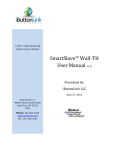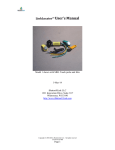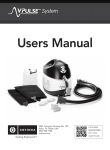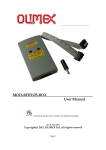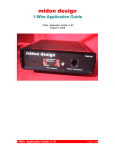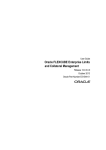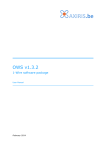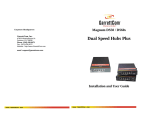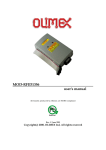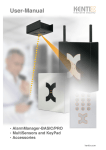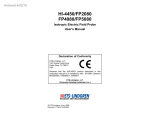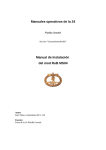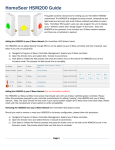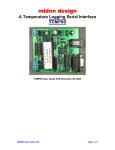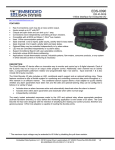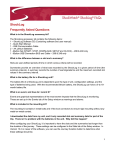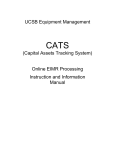Download MultiSensor manual
Transcript
The MultiSensor™ Users Guide Sensors for the 1-Wire™ Bus All current models of MultiSensor™ Published June 1, 2005 Revised October 2009 Copyright© 2005 by iButtonLink, LLC. iButton and 1-Wire are trademarks of Dallas Semiconductor Corp, Dallas, Texas, USA Page 1 of 11 INTRODUCTION: The MultiSensor family provides a very low cost solution for the need to monitor, measure, record and alarm, remote parameters. MultiSensors are not designed for high degrees of accuracy, but are intended more as relative indicators of the conditions they monitor. At this time there are five (5) variants of MultiSensor; Temperature only, Temperature plus Humidity, Temperature plus Light Intensity, Temperature plus DC voltage and Temperature plus AC Current. The MultiSensor family of products is designed to operate on the 1-wire™ bus structure, and as such, have many identical functions as well as unique functions. This document will address the similarities first. Common Features: All MultiSensor products are contained in a plastic box with mounting flanges. There is a RJ-45 connector on either end of the unit. This facilitates a simple connection of the sensor to +5 volts and ground on the 1-Wire® bus using cat 5E cables. The other connector provides a connection for the next sensor/device in the same manner. There is no polarity, or order to consider. The 1-Wire slaves are in parallel to one another. Pin assignments for the RJ-45 connectors are shown in appendix #1. The RJ-45 jacks will accept RJ-12 plugs as well. NOTE: These devices are not Ethernet compatible. The enclosures are not weather proof. They are intended for indoor use and to protect the electronics from coming in contact with external items that might cause failure or damage. The enclosure also provides for convenient mounting. All models of MultiSensors have the ability to measure temperature. As a necessary result, the enclosures have a cutout in the side to facilitate airflow to the sensing device. The opening is screened over to deter insects, or other foreign materials. Schematics for Multi-Sensor and all it’s variants, are available on this website by clicking on “Sensors”, and then selecting “MultiSensor Schematic”. The ADC used in all MultiSensors is a DS2438. Detailed information on this device can be found on this web site by selecting “Information and Documentation”. Then select application note “775” or select application note “524”. The latter will take you to the Dallas/Maxim web site and access to all of their application notes. How to Read MSxx Products is a valuable application note which can found on this web site by selecting “Information and Documentation”. Then select application note “AN0001”. Copyright© 2005 by iButtonLink, LLC. iButton and 1-Wire are trademarks of Dallas Semiconductor Corp, Dallas, Texas, USA Page 2 of 11 Temperature Considerations: The temperature measurement is made with a DS-2438Z. The device is not calibrated, but empirical data shows it to be accurate within a few degrees of actual, with an operating range of –40 to +85 degrees C. Because the sensing device is partially enclosed and mounted to the PCB, the response time to temperature changes will relatively slow. Care should be taken not to place the sensor in direct sunlight, as the radiant heat will be partially trapped inside the enclosure and cause readings higher than ambient. MultiSensors, like all 1-Wire™ slaves, can operate on “parasitic” power. That is, they use the power contained in data signal of the 1-Wire™ bus, with a capacitor to sustain them during the zeros. Unlike most other 1Wire™ devices, MultiSensors have an AUX jumper. This jumper connects the Vcc line on the sensor directly to the power source of the serial port (via the master Link), thus providing a constant Vcc to the sensor independent of what the line signal doing. The AUX jumper is set to provide Vcc when shipped from the factory. NOTE: If the AUX line of the master (Link) is being used for another purpose, the jumper on the sensor must be removed. The number of devices that can be connected to a particular 1-Wire network will vary a great deal, depending on the capabilities of the serial port supplying the network. Typically, ten to fifteen devices can be supported without additional external power. If additional power is required due to a large number of slaves, excessive bus length, or a weak supply from the serial port, a bus master with external power provisions (LinkHUB) must be used. MultiSensor model MS-TPS and MS-TPD MS-TPS (static) MS-TPD (differential) For temperature measuring considerations, see the MS-T section above. The MS-TPS and MS-TPD use the same pressure, or flow sensor, Omron, model D6F-P0010A. For details on the sensor, follow this link; http://www.ibuttonlink.com/pdf/omronsensor.pdf Copyright© 2005 by iButtonLink, LLC. iButton and 1-Wire are trademarks of Dallas Semiconductor Corp, Dallas, Texas, USA Page 3 of 11 The difference between the two devices is firm ware and the manner in which the input the barbs are handled. The MS-TPS has nothing connected to either of the inputs, and as a result, there is no difference in airflow from one input port to the other. The barometric pressure for the location is read. In the case of the MS-TPD, the inputs are re-directed by the use of a diverter element. The diverter will effect a 180 degree separation of the two inputs. The inputs can be extended with flex tubing, facilitating the measurement of differential pressures for air handling units, air conditioning systems etc. MultiSensor model MS-TC In addition to temperature measurement, the MS-TC will measure AC current in the range of 0 to 20 amps. While not calibrated, empirical data indicates a typical accuracy of +/-3% of reading. The response curve, established at 23 degrees C, is linear from .2 VDC (1 amp.) to 3.78 VDC (20 amps.). The zero current reading is .09 VDC. When used with a Link45 or Link12, the output will be voltage as stated above. When used with a LinkTH, the output will be a 3 digit reading from 1.00 to 20.0. Regardless of the Link model used, readings below 1 ampere and above 20 amperes are not specified. The sensing device used is a clamp-on current transformer. Dimensions are: 1.04”H x 1.04”W x 1.58”H. The “window” or aperture is .40” in diameter. The box containing the electronics is shipped with 3 feet of 18 gauge wire extending from it. It is up to the user to add or trim wire as desired and to make the final connection to the current transformer. Copyright© 2005 by iButtonLink, LLC. iButton and 1-Wire are trademarks of Dallas Semiconductor Corp, Dallas, Texas, USA Page 4 of 11 MultiSensor model MS-PWR The MS-PWR is not a sensor, but owing to it’s close relationship with the sensor products, it is included here. The device will enable the user to inject external power into the 1-Wire® network when the serial port power is insufficient to drive the network. The MS-PWR, is not a power supply! It will facilitate the use of an external source capable of supplying 12VDC to a 2.5mm coaxial connector, negative to the center post. For operation in the USA, the HubPwr device shown on our web site can be used. CAUTION! The MS-PWR must be connected as the first device on the network (logically closest to the master interface). Failure to comply can result in faulty readings and in extreme cases, damage to the serial port circuitry. MultiSensor model MS-TV In addition to the temperature measuring already discussed, the MS-TV can also measure DC voltage in the range of 0 to +10 volts. The voltage can be sourced from most any other sensor that produces a DC voltage signal in the range of 0 to +10 VDC. The device being measured by the MS-TV need not be 1-Wire compatible. Two 18 gauge sense wires, approximately 30 inches are extended from the unit box. Copyright© 2005 by iButtonLink, LLC. iButton and 1-Wire are trademarks of Dallas Semiconductor Corp, Dallas, Texas, USA Page 5 of 11 MultiSensor model MS-TL In addition to temperature measurement, the MS-TL can provide a general indication of light level. The maximum value of 5 volts corresponds to the light intensity of a 100 watt light bulb at a distance of 6 inches, while a zero volt reading indicates total darkness. To the amount that Vcc falls below +5 volts, the absolute maximum light level will become ambiguous. Most often this is not a concern since the device is intended to indicate light present, or no light present. Note: There is a hole in the top of the enclosure that is directly over the light sensor. Care should be taken to keep this opening clear and facing the light source to be monitored. MultiSensor model MS-TH In addition to temperature measurement, the MS-TH will measure relative humidity. The device used for humidity sensing is a Honeywell part, number HIH-4000. The linearity from 0% to 100% humidity is +/- .5%. Accuracy with +5 Vcc is 2% over the full range at 25 degrees C. Response time in slow moving air is typically 30 seconds. The Vcc supply must be sustained above 4 VDC, with 5 VDC being optimal. For complete details, see Appendix #2. When using a Link45 or Link12, humidity will be reported in the range of .8 VDC (zero percent humidity) to 4.07 VDC (100% humidity). When using a LinkTH, The readings will be converted to % humidity. Copyright© 2005 by iButtonLink, LLC. iButton and 1-Wire are trademarks of Dallas Semiconductor Corp, Dallas, Texas, USA Page 6 of 11 Appendix #1 The pin assignments listed below are viewed as looking into either jack on any MS-xx product. As a point of reference, the latch is on the bottom side of the jack. Pin 1 = 5 volt return Pin 2 = +5 volts Pin 3 = Aux return Pin 4 = 1-Wire® data Pin 5 = 1-Wire® return Pin 6 = AUX (Switched +5 volts) Pin 7 = V+ (+12 volts) Pin 8 = +12 volts return *This pin numbering convention was changed in June of 2005 to be consistant with industry standards. Copyright© 2005 by iButtonLink, LLC. iButton and 1-Wire are trademarks of Dallas Semiconductor Corp, Dallas, Texas, USA Page 7 of 11 Appendix #2 Copyright© 2005 by iButtonLink, LLC. iButton and 1-Wire are trademarks of Dallas Semiconductor Corp, Dallas, Texas, USA Page 8 of 11 Copyright© 2005 by iButtonLink, LLC. iButton and 1-Wire are trademarks of Dallas Semiconductor Corp, Dallas, Texas, USA Page 9 of 11 Copyright© 2005 by iButtonLink, LLC. iButton and 1-Wire are trademarks of Dallas Semiconductor Corp, Dallas, Texas, USA Page 10 of 11 Copyright© 2005 by iButtonLink, LLC. iButton and 1-Wire are trademarks of Dallas Semiconductor Corp, Dallas, Texas, USA Page 11 of 11











